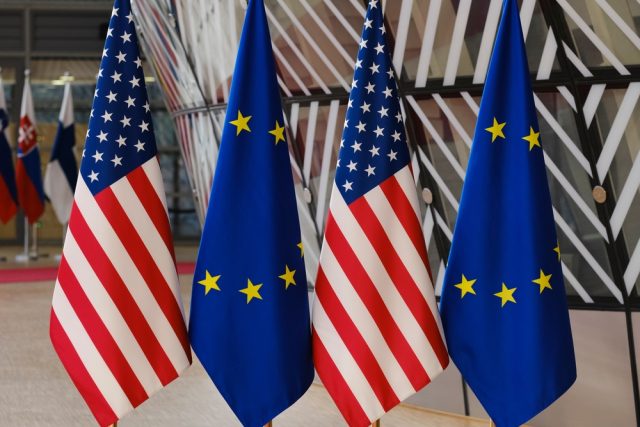
Brussels offers compromise ahead of G7 summit talks, while keeping €120 billion in retaliatory measures ready if negotiations fail
Brussels – With the countdown to the G7 summit underway, the European Union has offered a bold proposal to the United States in hopes of avoiding an escalating trade war under a potential second Trump administration. According to sources reported by Handelsblatt, the EU is willing to accept a fixed 10% tariff on all its exports to the U.S.—but only under strict conditions and as part of a broader, time-limited deal. The offer was made just hours before European Commission President Ursula von der Leyen’s scheduled meeting with Donald Trump on the sidelines of the G7 in Canada. Trump, now a leading contender in the 2024 U.S. presidential race, arrived at the summit with a large delegation, including Treasury Secretary Scott Bessent and U.S. Trade Representative Jamieson Greer, signaling the seriousness of the talks.
The proposed 10% tariff arrangement would serve as a cap, shielding European industries from steeper U.S. tariffs, especially in sensitive sectors such as automobiles, pharmaceuticals, and electronics. In exchange, Brussels would reduce its own tariffs on American-made vehicles and ease technical and legal restrictions to help U.S. carmakers gain traction in the European market. One of the more striking elements of the proposal involves energy. The EU has reportedly offered to ban the import of Russian natural gas altogether, which would likely boost demand for American liquefied natural gas (LNG). This measure aligns with Europe’s broader energy diversification strategy and carries significant geopolitical implications.
A Calculated Offer Amid Political Realities
The EU’s move is both pragmatic and preemptive. Brussels recognizes that Trump’s fiscal plans rely heavily on tariff revenue to offset the cost of sweeping tax cuts currently under review in Congress. This understanding has influenced the European Commission’s negotiating strategy, which seeks to find a middle ground before Trump potentially returns to office. Yet, EU officials remain cautious. No final agreement has been reached, and U.S. negotiators have not officially agreed to limit tariffs to 10%. A spokesperson for the Commission confirmed only that President von der Leyen and Trump had agreed to “continue working toward a deal by July 9.” That date is now seen as a critical deadline. For now, there is no confirmation of additional meetings this week between EU Trade Commissioner Maroš Šefčovič and American negotiators, and the atmosphere remains tense. Behind closed doors, Brussels is keeping its so-called “bazooka” in reserve: a comprehensive package of retaliatory measures worth up to €120 billion. This would be triggered if Washington imposes harsher trade barriers or walks away from talks altogether.
Von der Leyen: “All Tools Are on the Table”
On the eve of the G7, von der Leyen issued a warning: “If the result is not satisfactory, we are ready to respond. All instruments are on the table.” Her words were a clear signal that Europe will not hesitate to defend its economic interests if necessary. But the Commission president also struck a conciliatory tone, urging world leaders to stand united against protectionism. “We are so deeply interconnected that even risks must be managed together,” she said. “Tariffs don’t just affect exporters—they are taxes paid by families and businesses in the importing countries.” She emphasized that maintaining open, fair, and predictable trade relations is not only vital for economic stability but also sends a powerful message to global markets. “We must stay focused on the real structural challenges that deserve our attention,” she added.
Backdrop of Public Protest
As negotiations unfold, political tensions remain high both in Europe and the U.S. In New York City, protesters gathered under the banner “No Kings Day,” voicing opposition to Trump’s policies. One striking image from the rally featured a demonstrator holding a poster of Trump and Russian President Vladimir Putin locked in a satirical kiss—highlighting the polarization surrounding the former U.S. president’s global reputation. The EU’s 10% tariff offer represents a significant diplomatic gamble. It aims to contain the risk of a trade war while leaving enough leverage on the table should negotiations sour. Whether the offer will be accepted—and whether it will hold after July 9—remains to be seen. But one thing is clear: as global economic uncertainty mounts, both sides are acutely aware that missteps could have far-reaching consequences.



 Subscribe
Subscribe